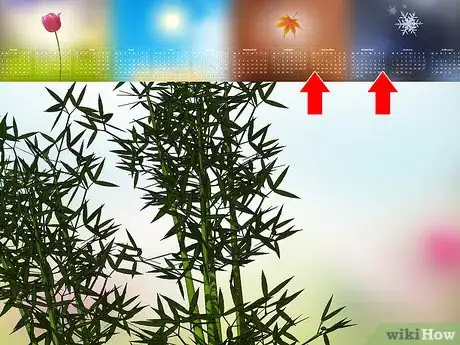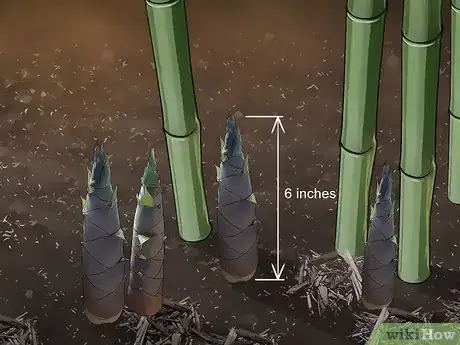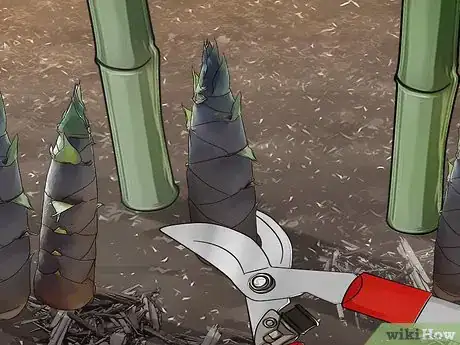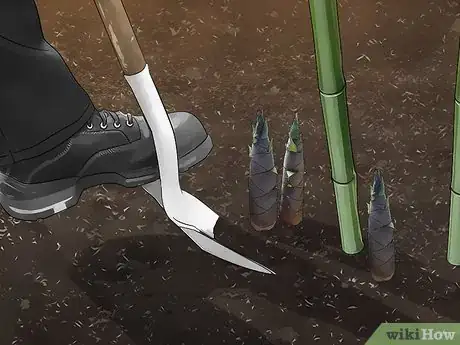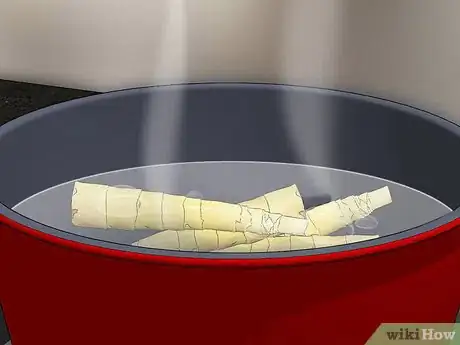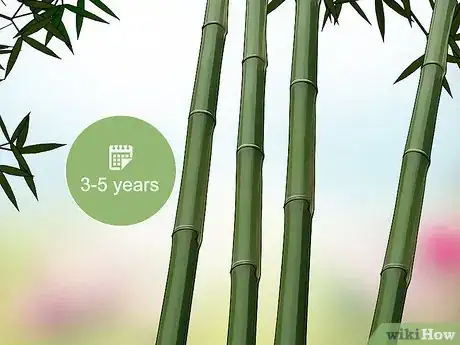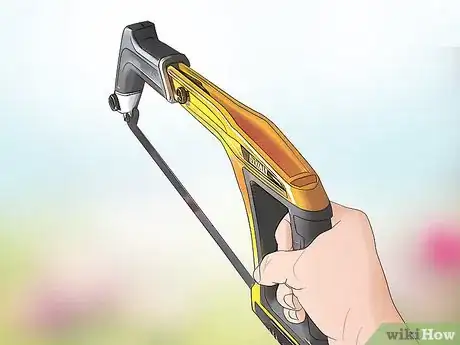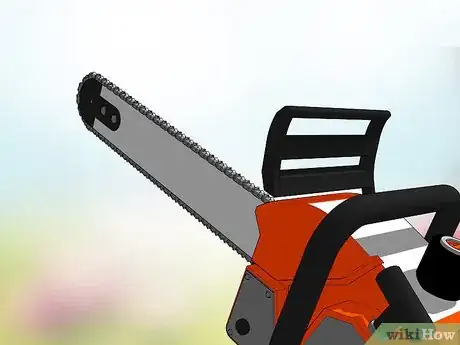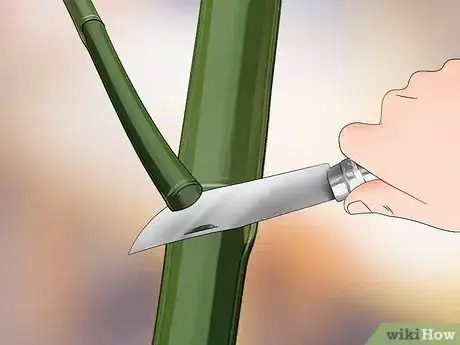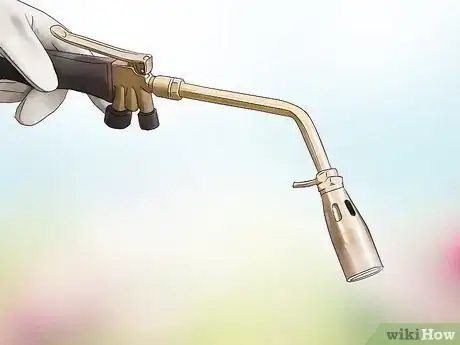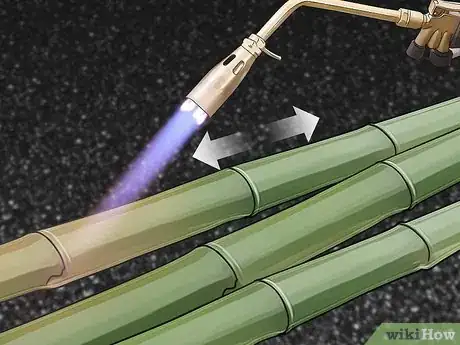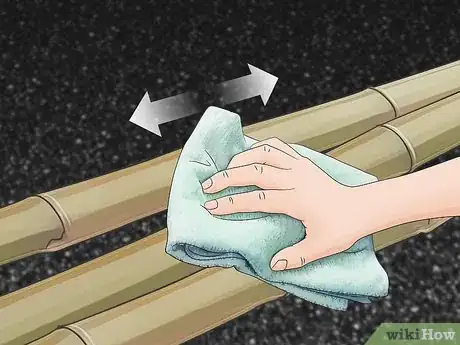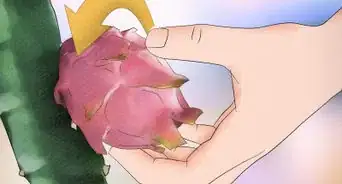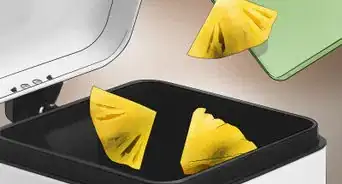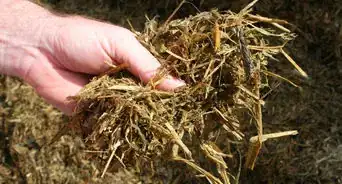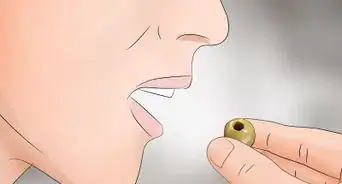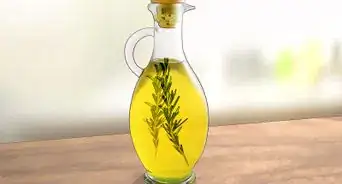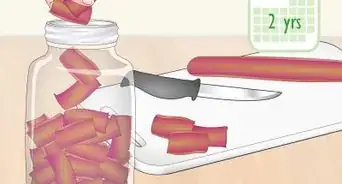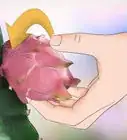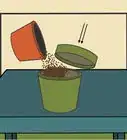This article was co-authored by Lauren Kurtz and by wikiHow staff writer, Hunter Rising. Lauren Kurtz is a Naturalist and Horticultural Specialist. Lauren has worked for Aurora, Colorado managing the Water-Wise Garden at Aurora Municipal Center for the Water Conservation Department. She earned a BA in Environmental and Sustainability Studies from Western Michigan University in 2014.
There are 14 references cited in this article, which can be found at the bottom of the page.
This article has been viewed 23,943 times.
Bamboo is a popular, woody grass that can be eaten or used for a variety of projects, such as furniture or flooring. Culinary bamboo needs to be peeled and blanched before it can be eaten. Mature bamboo needs to be cured with heat to prevent molding. With common tools, you can enjoy bamboo no matter what you use it for!
Steps
Harvesting Edible Shoots
-
1Harvest bamboo at the start of the dry season. During the wet seasons, bamboo is more starchy and will be more difficult to cut and could cause splitting. Plan to harvest your bamboo during the fall or winter so the bamboo is the easier to harvest.[1]
- Start your harvest before sunrise since the starches will still be held in the roots at that time.
-
2Choose shoots less than 6 in (15 cm) tall with a wide base. Shorter shoots will grow on the outer edge of the bamboo patch. Avoid using shoots that are soft to the touch since this could mean they are diseased. Don’t use bamboo that has visible mold, fungi, or cracks in the shoots.[2]Advertisement
-
3Use loppers to harvest bamboo less than 1.5 in (3.8 cm) thick. Hold the loppers near the end of the handles to have the widest range of motion. Open them until the stalk fits between the blades and close them slowly so the bamboo is not damaged. Cut the bamboo as close to the ground as you can.[3]
- Loppers can be purchased at any gardening store.
- Closing the loppers too fast could crack and damage the bamboo stalk, preventing it from regrowing.
-
4Dig the base with a shovel to get the whole shoot. Stab the blade of the shovel into the ground underneath the shoot you’re pulling out. Push down on the shovel handle to loosen the shoot and the dirt. Once the dirt is loose, pull the shoot from the ground.[4]
- Try pulling the shoot sideways with your hands first. They may be loose enough to pull by hand.
-
5Peel the skin off of the bamboo. Use a sharp paring knife to cut into the outer skin of the bamboo, but do not cut all the way through the shoot. Twist the woody outer layer off of the shoot and dispose of it.[5]
- Fresh peeled bamboo only keeps for 1 to 2 days.
- You can cut the shoots to any size that is convenient for you.
-
6Blanch the shoots over medium heat. Use ½ teaspoon (3 g) of salt per 1 cup (240 mL) of water in a large pot. Bring the water to a boil and then turn down the heat so they simmer for 5-10 minutes. This helps remove the bitter flavor but keeps them crunchy.[6]
- Store the shoots in salted water for up to 5 days. Put the blanched shoots in a jar of salted water with ½ teaspoon (3 g) of salt per 1 cup (240 mL) of water. Label the date you prepared the bamboo and place the jar in the fridge.[7]
- You can also freeze the shoots in salted water to preserve them for longer.
Cutting Mature Bamboo Canes
-
1Select culms that are between 3-5 years old. Look for stalks that have a lime-green color with red spots of pigmentation. Older bamboo stalks will be near the center of your bamboo patch while newer shoots will be around the outside.[8]
- Tap the stalks with a pen or your finger. Younger stalks will sound have a deeper noise while older bamboo will sound hollower and metallic.
- Look at the branches growing from the bamboo. Young bamboo will have only 1 or 2 branches growing and old bamboo will have many.
-
2Cut with a sharp hacksaw for thicker bamboo stalks. Place the blade of the saw against the bamboo stalk and use a back and forth motion to cut through it. Using a sharp saw will give you the cleanest cut through the bamboo.[9]
- Hacksaws are available for purchase at hardware stores or online.
- Hacksaws are less flexible than regular saws and will make it easier to make a clean cut through the bamboo.
-
3Operate a chainsaw for mature bamboo to cut it quickly. Start your chainsaw and hold it near the stalk of bamboo you wish to harvest. Push the saw through the bamboo with consistent pressure until it passes through the bamboo completely.[10]
- Wear gloves and safety glasses when you operate a chainsaw to protect yourself from debris.
- Cutting bamboo will dull the chain on the saw much faster than normal.
- Make sure you know which direction you intend for the bamboo to fall so that there is nothing in the way.
-
4Make your cut above the first or second node from the ground. The nodes are the bands that wrap around the stalks of bamboo. Cut at an angle so water can easily run off the culm so it does not rot.[11]
- Bamboo that has been cut can grow back during the coming growing seasons.
-
5Remove the branches and leaves. Use your saw or a sharp knife to cut away any growths on the main stalk of your bamboo. Cut as close to the main culm of bamboo as you can.[12]
Curing Mature Bamboo Canes
-
1Use a blowtorch or grill as a heat source. Make sure the temperature of the flame is around 120 °C (248 °F) so the interior oils will come to the surface of the bamboo stalk.
- Use caution when working with an open flame so you do not burn yourself.
- Wear gloves throughout the process since the bamboo stalks can get very hot.
- A gas grill or a charcoal grill will work fine for this process.
-
2Apply heat to the end of the bamboo stalk in back and forth strokes. Start at one end of the stalk and work the area up to the closest node. The bamboo will turn from light green to dark green as the oils rise to the surface.[13]
- Heating the bamboo will also clean it of any blemishes.
-
3Wipe the oil off of the culm with a towel. After 10 seconds of heating an area of bamboo, use a microfiber towel to wipe away the oil that releases from the stalk. The bamboo will look shiny as the oil rises to the surface and as you wipe it off.[14]
- Fold the towel in half to protect yourself from the heat.
-
4Work with the heat until the bamboo turns a yellowish-brown. Keep heating and wiping the bamboo until it turns yellow. You can continue heating and curing the bamboo until it reaches the desired color.[15]
- Cured bamboo will be protected from fungi and insect infestation.
Community Q&A
-
QuestionHow far apart should I plant the bamboo?
 T. ChinsenTop AnswererThe general recommendation is 3 - 5 feet. A lot depends on the variety and what type of garden feature it will become. Check out Plant a Clumping Bamboo to help get a perspective on the process of planting bamboo.
T. ChinsenTop AnswererThe general recommendation is 3 - 5 feet. A lot depends on the variety and what type of garden feature it will become. Check out Plant a Clumping Bamboo to help get a perspective on the process of planting bamboo. -
QuestionIf I want to bend mature bamboo, should I do the curing process before or after the bending?
 Community AnswerYou should do the curing process after the bending. If you do the curing process first, the bamboo will be too hard to bend.
Community AnswerYou should do the curing process after the bending. If you do the curing process first, the bamboo will be too hard to bend.
Warnings
- Wear gloves and eye protection when working with a chainsaw to protect yourself from flying debris.⧼thumbs_response⧽
- Use caution when working with an open flame so you don’t burn yourself.⧼thumbs_response⧽
- Whenever you use a chainsaw, be sure to wear work boots, pants and long sleeves.⧼thumbs_response⧽
Things You’ll Need
Harvesting Edible Shoots
- Loppers
- Shovel
- Paring knife
- Large pot
- Glass jar
Cutting Mature Bamboo
- Hacksaw
- Chainsaw
Curing Mature Bamboo Canes
- Blowtorch
- Grill
- Gloves
- Towel
References
- ↑ https://youtu.be/wXcmtHM-ueg?t=2m59s
- ↑ https://harvesttotable.com/bamboo_shoots_stalk_vegetable/
- ↑ https://youtu.be/1XPfk1myTgw?t=33s
- ↑ https://youtu.be/kFmgnBJ8ajE?t=1m41s
- ↑ https://youtu.be/Ywj9NEAIHUA?t=1s
- ↑ http://extraslaw.com/bamboo-shoots-harvesting-preparing-and-pickling-wild-bamboo/
- ↑ http://extraslaw.com/bamboo-shoots-harvesting-preparing-and-pickling-wild-bamboo/
- ↑ https://youtu.be/wXcmtHM-ueg?t=1m15s
- ↑ https://youtu.be/wXcmtHM-ueg?t=2m43s
